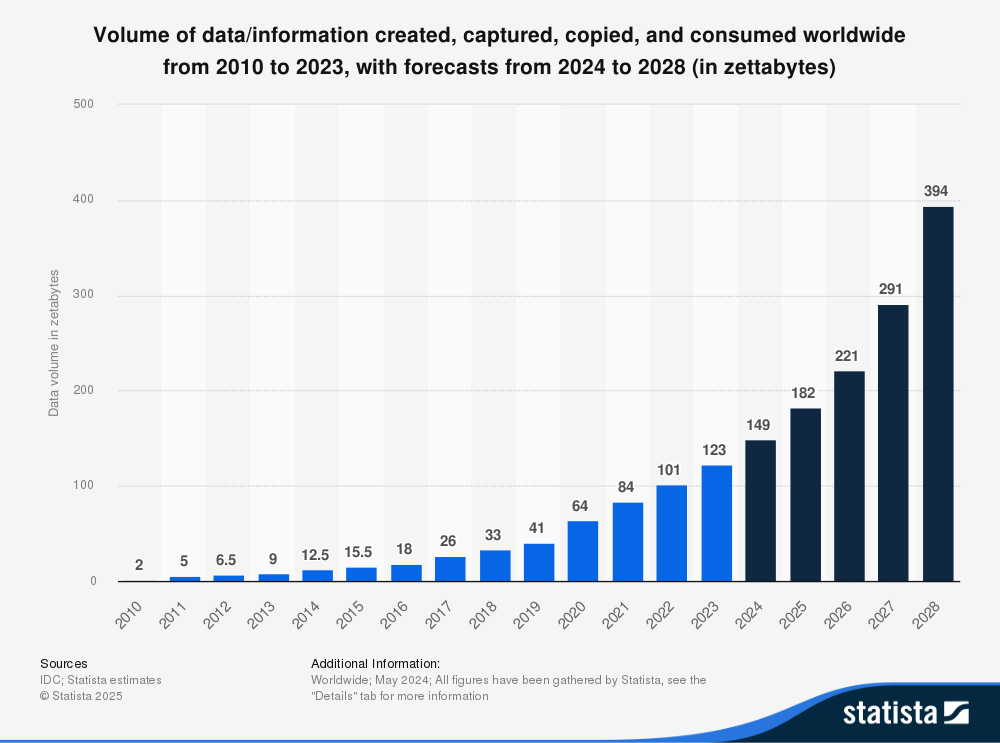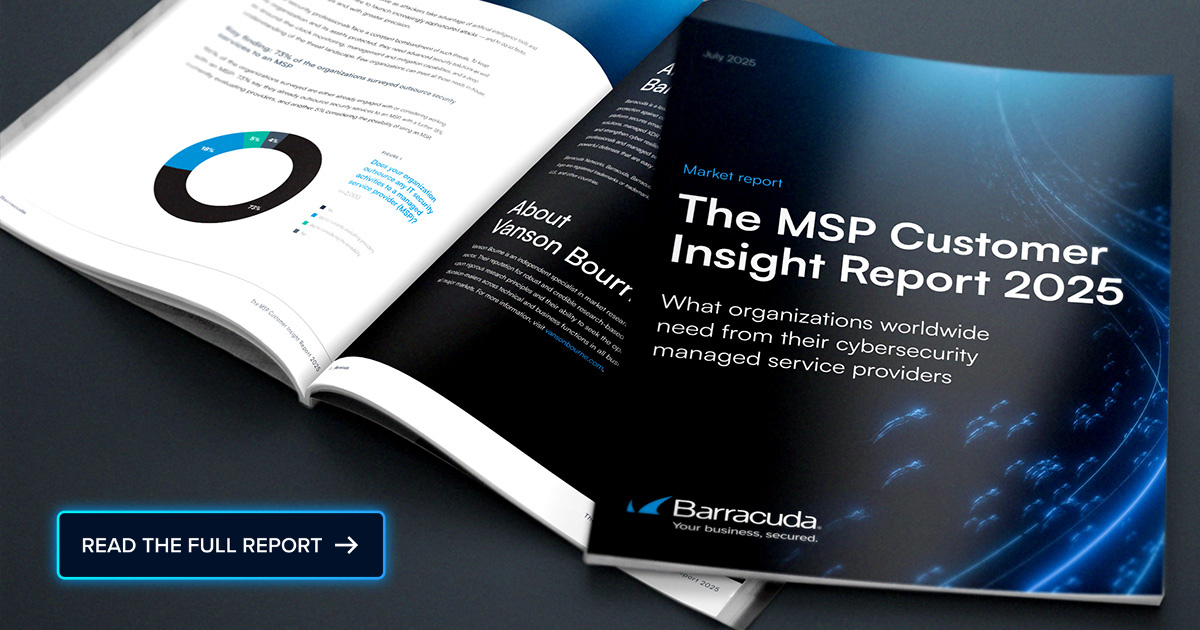
 On March 23 2011, a Redditor proposed a “Back-Up Day” to a community full of tech enthusiasts. “I just think it would be for the good of everyone to have a reminder to save all your cherished pictures, videos and other important data to somewhere secure.” Eight days later, World Backup Day was a big Reddit-based event.
On March 23 2011, a Redditor proposed a “Back-Up Day” to a community full of tech enthusiasts. “I just think it would be for the good of everyone to have a reminder to save all your cherished pictures, videos and other important data to somewhere secure.” Eight days later, World Backup Day was a big Reddit-based event.
The generation and protection of data has increased exponentially since then. Digital acceleration, industry 4.0, online content, and the proliferation of personal devices and smart ‘things’ have elevated data to a high-priority asset.

Data growth recorded and forecasted, 2010 – 2028
Data backup solutions have evolved as well, with advancements in external hard drives, purpose-built backup servers, cloud-based backup solutions, and software enhancements that have automated much of the backup process. World Backup Day (WBD) may seem unnecessary now, but it’s never been more critical to set aside time to consider your systems and data protection.
Why World Backup Day?
There are challenges to data protection, and WBD gives us a good reason to focus on these challenges and find solutions. Let’s start with some of the most asked questions around WBD:
Why do we need World Backup Day? WBD reminds individuals and organizations to reassess their backup practices, ensuring they are prepared for potential data loss scenarios.
Shouldn’t we backup every day? Yes, though the intervals depend on the needs of the business. An annual day of awareness is about the reduction of potential harm. It’s an opportunity to educate each other about the value and protection of data.
Isn’t everything in the cloud anyway? Cloud services like Microsoft OneDrive offer automatic syncing and storage, but it still requires configuration. It’s also important to note that file synchronization is not a data backup. File synchronization is not acceptable for business backup.
With this in mind, let’s get into some of the most common data protection challenges faced by companies today.
The top considerations when choosing a backup solution
Backup solutions are easy to find, but selecting the best solution for your needs can be a challenge. Here are some of the most common factors considered when selecting a backup appliance and service:
Scalability: A scalable solution accommodates business growth without requiring frequent changes. These backup services can expand your storage capacity as needs evolve, without performance degradation.
Flexibility: You need to protect your data whether it resides in the cloud, on-premises, at individual edge locations, or a combination of these. Your backup architecture needs to reach your data wherever it is. A single-vendor solution with multiple deployment options is made for this purpose.
Ease of use: User-friendly solutions reduce administrative overhead and minimize the risk of human error. Backup Administrators look for automation for routine tasks, comprehensive reporting and monitoring tools, and an intuitive user interface for easy administration.
Recovery environment flexibility: This ensures you can restore data under various scenarios, including disaster recovery situations. You may need to restore from physical to virtual or on-premises to cloud.
Barracuda Backup meets all these requirements and more. Our on-premises models are available through simple per-terabyte subscription licensing, so you have no large up-front expenditures to accommodate data growth. With a Barracuda Cloud subscription, you can recover data from anywhere at any time, without the need for your local appliance. Barracuda LiveBoot offers companies the option to boot virtual machines from backup images in case the virtual environment goes offline. Details on these features can be found on our website.
Commonly overlooked applications and data types
This is the area where WBD can be most valuable. Even the most thorough plan may have gaps. As you evaluate your backup strategy, make sure you’re backing up everything you need.
Web application and cloud-based data: Data stored exclusively in the cloud is often overlooked during backups. Cloud services may offer limited version histories and recovery options, but the responsibility for data protection is with the customer. Entra ID information or data shared in Microsoft Teams may be mission critical but can still be forgotten when configuring backups. Take inventory of everything used by the organization and ensure the data is protected by third-party backup solutions specifically designed for these platforms.
Proprietary software and database applications: IT teams might miss data generated within an application or database that isn’t well understood. Work closely with application vendors to determine best practices for backing up these systems. Evaluate these backups regularly to ensure that data growth is not outpacing the space available for backups.
Historical and legacy data: Some companies intentionally keep their backups of old data, but they purge the old data from their systems. If this data is on tapes or external hard drives, it’s at risk of physical failure. The tape drive might not be available, and hard drives don’t always spin up when they’ve been idle for a long time. If the legacy data is important, move it to a modern backup system.
Operational technology and other smart devices: Industrial Internet of Things (IIoT) devices have become integral to manufacturing, transportation, healthcare, and almost every type of critical infrastructure. They often have complex configurations and may keep data on the device between transmissions. Backing up this data supports a faster recovery and return to production in the event of failure.
Barracuda Backup supports application-aware backup and recovery of Microsoft SQL and Microsoft Exchange applications. Barracuda Cloud-to-Cloud Backup supports Microsoft 365 Teams, Groups, Exchange, SharePoint, OneDrive, and OneNote, as well as Entra ID data.
Commonly overlooked data backup practices
Many organizations have gaps in their backup strategies. Consider taking some time to evaluate your plans and make sure everything works.
Regular testing of backups and recovery processes: Schedule regular tests of backups and recovery processes to identify problems ahead of time. Corrupted or incomplete backups and misconfigurations may otherwise go unnoticed until a disaster occurs.
Protecting endpoint devices: Laptops, mobile devices, and desktops may contain critical business data but are frequently excluded from backup strategies. These devices may be more at risk of theft or damage due to their mobility. Additionally, being placed in a remote work environment increases their vulnerability.
Offsite Backup and the 3-2-1 Rule: The 3-2-1 rule refers to the practice of keeping three copies of data on at least two different media types, with one stored offsite. An easy way to implement this is to use a backup solution that will automatically replicate backups to the cloud or a secondary physical location.
Implement role-based access control (RBAC) for backup management: Backup operators and administrators only need the permissions necessary to perform their roles. RBAC is a critical security and management practice for backup systems. Assigning different roles to individuals who interact with backup environments ensures operational efficiency and minimizes risks. It also enhances security and helps maintain compliance with security policies.
Barracuda Backup supports five user roles secure access. This minimizes the chances of an attacker accessing the backup system with the most powerful administrative privileges.
Data backup as a ransomware strategy
There’s no denying that reliable data backups are a cornerstone of ransomware defense. Most advanced ransomware strains include the destruction of data backups as part of the attack chain. Barracuda makes it a priority to keep your backup safe from threat actors:
Immutable backup protection ensures that once data is written, it cannot be altered or deleted by ransomware, preserving the integrity of your backups.
A hardened Linux platform (operating system) reduces the attack surface and vulnerabilities that ransomware could exploit, making it more difficult for malware to infiltrate the backup system.
Multifactor authentication (MFA) adds an extra layer of security by preventing unauthorized access to backup systems, even if ransomware attackers compromise passwords.
Secure, air-gapped cloud storage physically isolates backups from the primary network, making them inaccessible to ransomware that may have infected the main system.
Integrated backup software, storage, and off-site storage creates a comprehensive, unified defense against ransomware by eliminating potential vulnerabilities between disparate systems.
Role-based access control limits user privileges and reduces the potential impact of a ransomware attack by restricting data access or modifications for any single compromised account.
Eliminating network sharing protocols removes common entry points that ransomware often exploits to spread across networks and infect backups.
End-to-end encryption ensures that even if ransomware manages to access backup data, it remains unreadable and unusable to the attackers.
The ability to create IP/network restrictions allows you to limit access to backup systems from specific, trusted locations, reducing the risk of ransomware infiltrating your backup environment.
When purchasing a backup solution, prioritize features that support efficient and reliable data recovery. Focus on solutions that offer rapid recovery times, granular recovery options, and flexible recovery environments. Look for solutions with automated testing capabilities and robust data integrity verification. These considerations will help ensure that your chosen backup solution protects your data effectively. They will also enable swift and efficient recovery when needed.
Find out more about Barracuda’s award-winning data protection:
- Barracuda Backup
- Barracuda Cloud-to-Cloud Backup
- Barracuda Entra ID Backup
- Malware detection for Cloud-to-Cloud Backup
- The need for Barracuda Cloud-to-Cloud Backup for Microsoft 365
- Barracuda protects Microsoft Entra ID from misconfiguration and malicious attack
- The benefits of Barracuda’s new scalable backup
This article was originally published at Barracuda Blog.
Photo: Romolo Tavani / Shutterstock

